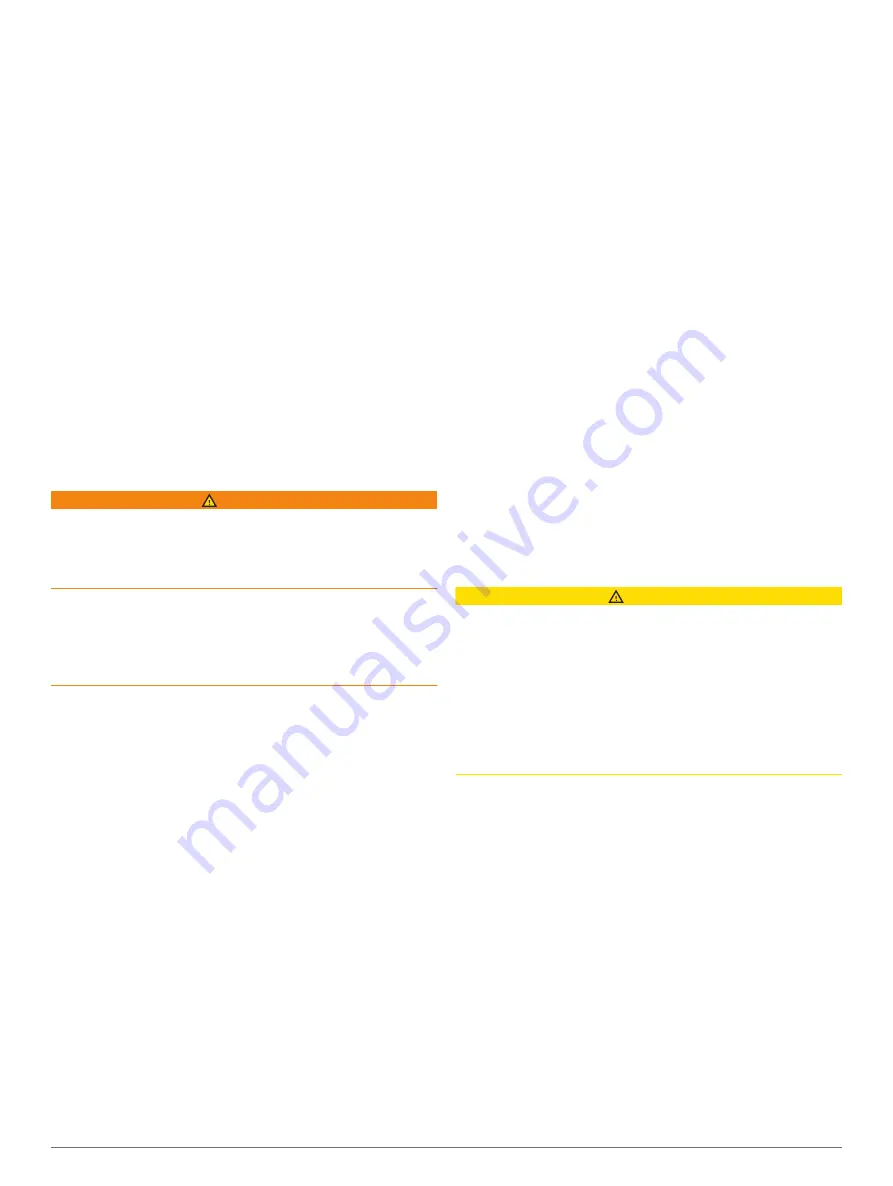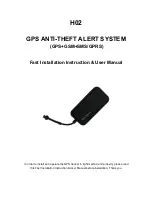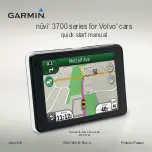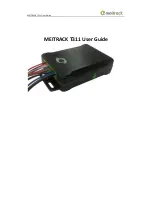
1
Select
Info
>
User Data
>
Routes & Auto Guidance Paths
>
New
>
Route Using SAR Pattern
.
2
Select a pattern:
• Select
Sector Search
when the location of the object is
fairly known, the search area is small, and an intensive
search is needed.
• Select
Expanding Square
when the location of the object
is somewhat doubtful, the search area is small, and an
intensive search is needed.
• Select
Creeping/Parallel Line
when the location of the
object is approximate, the search area is small, and a
consistent search is needed.
3
Enter the search parameters.
4
Select
Done
.
5
If necessary, select
Engage
.
Deleting a Saved Route
1
Select
Info
>
User Data
>
Routes & Auto Guidance Paths
.
2
Select a route.
3
Select
Review
>
Delete
.
Deleting All Saved Routes
Select
Info
>
User Data
>
Delete User Data
>
Routes &
Auto Guidance Paths
.
Auto Guidance
WARNING
The Auto Guidance feature is based on electronic chart
information. That data does not ensure obstacle and bottom
clearance. Carefully compare the course to all visual sightings,
and avoid any land, shallow water, or other obstacles that may
be in your path.
All route and navigation lines displayed on the chartplotter are
only intended to provide general route guidance or to identify
proper channels, and are not intended to be precisely followed.
Always defer to the navaids and conditions on the water when
navigating to avoid groundings or hazards that could result in
vessel damage, personal injury, or death.
NOTE:
Auto Guidance is available with premium charts, in some
areas.
You can use Auto Guidance to plot the best path to your
destination. Auto Guidance uses your chartplotter to scan chart
data, such as water depth and known obstacles, to calculate a
suggested path. You can adjust the path during navigation.
Setting and Following an Auto Guidance Path
1
Select a destination (
).
2
Select
Navigate To
>
Auto Guidance
.
3
Review the path, indicated by the magenta line.
4
Select
Start Navigation
.
5
Follow the magenta line, steering to avoid land, shallow
water, and other obstacles.
NOTE:
When using Auto Guidance, a gray segment within
any part of the magenta line indicates that Auto Guidance
cannot calculate part of the Auto Guidance line. This is due to
the settings for minimum safe water depth and minimum safe
obstacle height.
Creating and Saving an Auto Guidance Path
1
Select
Info
>
User Data
>
Routes & Auto Guidance Paths
>
New
>
Auto Guidance
.
2
Select a starting point, and select
Next
.
3
Select a destination, and select
Next
.
4
Select an option:
• To view a hazard and adjust the path near a hazard,
select
Hazard Review
.
• To adjust the path, select
Adjust Path
, and follow the on-
screen instructions.
• To delete the path, select
Cancel Auto Guidance
.
• To save the path, select
Done
.
Adjusting a Saved Auto Guidance Path
1
Select
Info
>
User Data
>
Routes & Auto Guidance Paths
.
2
Select a path, and select
Review
>
Edit
>
Adjust Path
.
TIP:
When navigating an Auto Guidance path, select the path
on the navigation chart, and select Adjust Path.
3
Select a location on the path.
4
Drag the point to a new location.
5
If necessary, select a point, and select
Remove
.
6
Select
Done
.
Canceling an Auto Guidance Calculation in Progress
From the Navigation chart, select
Menu
>
Cancel
.
TIP:
You can select Back to quickly cancel the calculation.
Setting a Timed Arrival
You can use this feature on a route or an Auto Guidance path to
get feedback about when you should arrive at a selected point.
This allows you to time your arrival at a location, such as a
bridge opening or a race starting line.
1
From the Navigation chart, select
Menu
.
2
Select
Navigation Options
>
Timed Arrival
.
TIP:
You can quickly open the Timed Arrival menu by
selecting a point on the path or route.
Auto Guidance Path Configurations
CAUTION
The Preferred Depth and Vertical Clearance settings influence
how the chartplotter calculates an Auto Guidance path. If an
area has an unknown water depth or an unknown obstacle
height, the Auto Guidance path is not calculated in that area. If
an area at the beginning or the end of an Auto Guidance path is
shallower than the Preferred Depth or lower than the Vertical
Clearance settings, the Auto Guidance path may not be
calculated in that area, depending on the map data. On the
chart, the course through those areas appears as a gray line or
a magenta and gray striped line. When your boat enters one of
those areas, a warning message appears.
NOTE:
Auto Guidance is available with premium charts, in some
areas.
NOTE:
Not all settings apply to all maps.
You can set the parameters the chartplotter uses when
calculating an Auto Guidance path.
Preferred Depth
: Sets the minimum water depth, based on
chart depth data, that your boat can safely travel over.
NOTE:
The minimum water depth for the premium charts
(made before 2016) is 3 feet. If you enter a value of less than
3 feet, the charts only use depths of 3 feet for Auto Guidance
path calculations.
Vertical Clearance
: Sets the minimum height of a bridge or
obstacle, based on chart data, that your boat can safely
travel under.
Shoreline Distance
: Sets how close to the shore you want the
Auto Guidance path to be placed. The Auto Guidance path
may move if you change this setting while navigating. The
available values for this setting are relative, not absolute. To
ensure that the Auto Guidance line is placed the appropriate
distance from shore, you can assess the placement of the
Auto Guidance path using one or more familiar destinations
18
Navigation with a Chartplotter
Summary of Contents for GPSMAP A12
Page 1: ...GPSMAP A12 Owner sManual...
Page 8: ......
Page 73: ......
Page 74: ...support garmin com December 2018 190 02262 00_0D...















































